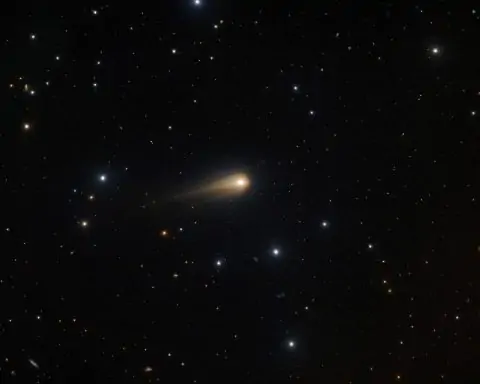- SpaceX launches a classified NRO spy satellite mission from California, marking the 11th “proliferated architecture” batch of U.S. reconnaissance minisats [1] [2].
- NASA unveils 10 new astronaut candidates (5 men, 5 women) selected from 8,000+ applicants to train for Artemis moon missions and future Mars journeys [3] [4].
- Blue Origin clinches a $190 million NASA contract to land the VIPER lunar rover in 2027, reviving a mission that was previously stalled by delays [5] [6].
- NASA’s safety advisors warn SpaceX’s Starship moon lander may be “years late” for the planned 2027 Artemis III lunar mission, citing challenging tech milestones [7] [8].
- SpaceX logs its 119th Falcon 9 launch of 2025, sending 28 Starlink internet satellites to orbit and further expanding its global broadband megaconstellation [9].
Rocket Launches and Satellite Deployments
Spy sats on the West Coast: SpaceX lofted another batch of classified U.S. spy satellites on Sept. 22, with a Falcon 9 roaring off Vandenberg Space Force Base at 1:38 p.m. EDT (10:38 a.m. local) [10]. The NROL-48 mission – SpaceX’s 11th dedicated launch for the National Reconnaissance Office’s new “proliferated architecture” – carried a cluster of undisclosed reconnaissance payloads. The NRO is pivoting to large numbers of smaller satellites instead of a few big ones, aiming to deliver “an order of magnitude more signals and images” with faster revisit times and resilience [11]. SpaceX’s webcast cut off early at the NRO’s request, but the Falcon 9’s first stage (on its 18th flight) landed safely back at Vandenberg [12]. “To stay ahead… the NRO is modernizing its architecture… delivering more capability faster with increased resilience,” officials said of the shift to many mini-satellites [13].
Starlink surge continues: Barely a day later, SpaceX notched yet another Falcon 9 launch from Florida’s Cape Canaveral. In an early-morning liftoff, a Falcon 9 deployed 28 new Starlink broadband satellites into low Earth orbit, marking SpaceX’s 119th mission of the year [14]. This flight (dubbed Starlink 10-27) took off at 6:53 a.m. EDT and further grew the Starlink constellation, which now numbers well over 5,000 satellites. It also pushed SpaceX to a record-breaking cadence – roughly 280 orbital launches in the company’s history so far [15]. The rapid-fire Starlink deployments underscore SpaceX’s push to blanket the globe in internet coverage, even as astronomers and regulators keep eyes on the megaconstellation’s impacts.
Sea-launch record in China: In Asia, China’s Shandong province grabbed headlines for an ambitious offshore rocket launch. Earlier this month, a sea-based Smart Dragon-3 (Y7) rocket mission from Shandong’s coast deployed 115 small satellites to orbit, the largest batch ever launched by China in one go [16]. This mission – Shandong’s second sea launch within a month – highlights the region’s emergence as a commercial space manufacturing and launch hub. Provincial officials report 18 sea launches to date, enabled by a complete local supply chain (factories capable of building 50 solid-fuel rockets per year and a new line for 100 satellites annually in the 500 kg class) [17]. The feat not only boosts China’s rapid deployment capabilities but also signals growing global competition in the smallsat launch market.
Space weather observatory set to fly: Meanwhile, NASA and NOAA are gearing up for a multi-satellite science launch. A SpaceX Falcon 9 is poised to loft three space weather probes – NASA’s IMAP (Interstellar Mapping and Acceleration Probe) plus two piggyback missions – on the morning of Sept. 24 [18] [19]. Liftoff is targeted for 7:30 a.m. EDT from Kennedy Space Center. IMAP will journey ~1.5 million km to the Sun–Earth L1 Lagrange point, to map the boundary of the heliosphere (the Sun’s protective bubble) and study how solar wind and cosmic particles interact with it [20]. Hitching a ride are the Carruthers Geocorona Observatory (CGO), a smallsat imaging Earth’s tenuous exosphere, and NOAA’s SWFO-L1 (Space Weather Follow-On) satellite [21]. SWFO-L1 will serve as an early-warning sentinel for solar storms, monitoring the Sun from L1 to give ~30 minutes notice of incoming geomagnetic disruptions [22]. This trio of spacecraft will augment our space weather monitoring network, replacing aging satellites and improving forecasts [23]. (NASA had initially set the launch for Sept. 23 but moved it to Sept. 24 after final prep updates [24] [25].)
NASA Updates: Astronauts and Artemis Missions
New astronauts named: For the first time since 2021, NASA has welcomed a new astronaut candidate class. In a ceremony at Johnson Space Center on Sept. 22, NASA introduced 10 astronaut candidates – four men and six women – selected from over 8,000 applicants [26]. The diverse group (which includes pilots, engineers, scientists and medical doctors) will begin two years of intensive training in January, prepping for future missions to the ISS, the Moon and beyond [27]. “This selection was… very difficult, but… we have a group of individuals who are not only exceptional but… inspirational for the United States of America, and for our planet,” said Norm Knight, NASA’s Flight Operations Director, in introducing the recruits [28]. These candidates – the 24th class in NASA history – could play key roles in the Artemis program. They’ll likely graduate just as NASA aims to return humans to the Moon on Artemis III in the late 2020s [29], and some may even be part of the first crews to venture toward Mars in the 2030s.
Artemis II mission preview: NASA is also in full swing preparing for Artemis II, the agency’s next big crewed mission. On Sept. 23, officials held briefings at JSC to preview the Artemis II Moon mission, slated for no earlier than April 2026 [30]. Artemis II will launch a crew of four (NASA astronauts Reid Wiseman, Victor Glover, Christina Koch, and CSA astronaut Jeremy Hansen) on a ~10-day journey around the Moon and back [31]. It will be the first crewed flight of the Space Launch System (SLS) megarocket and Orion spacecraft, following the uncrewed Artemis I test flight in 2022. The crew won’t land on the Moon, but they’ll loop around it – even venturing 1.09 million km from Earth, the farthest humans will have traveled from our planet. Artemis II’s objectives are to validate deep-space life support systems and practice operations in lunar orbit, paving the way for a lunar landing on Artemis III [32]. During the briefings, mission managers highlighted new upgrades, such as Orion’s augmented radiation monitors and the deployment of 10 small science CubeSats during the flight [33]. The astronauts themselves have been busy training in simulators (even sporting their moonwalking suits in mock countdown drills) [34]. NASA has a packed schedule of media events, including another crew press conference on Sept. 24 and an “Artemis II media day” with hands-on hardware demos [35] [36] – underscoring the mission’s significance as a stepping stone to returning humans to the Moon after five decades.
Artemis III schedule worries: Even as Artemis II moves forward, questions loom over Artemis III, the first lunar landing mission of the program. On Sept. 22, a report from NASA’s Aerospace Safety Advisory Panel (ASAP) flagged significant delays in SpaceX’s Starship – the vehicle chosen as the Artemis III lunar lander [37]. After visiting SpaceX’s Starbase facilities, the safety panel warned the current 2027 target for Artemis III is at serious risk. “The HLS [Human Landing System] schedule is significantly challenged and in our estimation could be years late for a 2027 Artemis III Moon landing,” said panel member Paul Hill [38] [39]. The Starship lander must demonstrate complex on-orbit refueling and multiple flight tests before it can carry astronauts – technologies never done before that panelists say face “aggressive” timelines [40] [41]. Any slip in developing Starship or the new lunar spacesuits could push Artemis III to 2028 or beyond, the panel noted [42]. NASA officials insist they’re monitoring progress closely. (In fact, NASA’s new Acting Administrator, Jeff Duffy, recently doubled down that he “’ll be damned” if China lands on the Moon before the U.S. returns [43].) SpaceX’s pace remains breakneck – the company aims to test a new Starship variant next month – but ASAP urged NASA to reassess Artemis III’s schedule and risks, potentially offloading some objectives to later missions [44]. The warning is a reality check that the 2025–2027 timeline for planting Americans back on the Moon faces formidable technical hurdles.
Commercial & Industry Developments
Blue Origin’s lunar lander win: Jeff Bezos’ Blue Origin scored a high-profile victory on Sept. 22, as NASA awarded the company the contract to deliver its VIPER rover to the Moon. The space agency had canceled the VIPER mission last year due to delays with the prior contractor, but now the Volatiles Investigating Polar Exploration Rover (VIPER) is back on track for a late 2027 lunar landing [45] [46]. Under the ~$190 million deal (a task order in NASA’s Commercial Lunar Payload Services program), Blue Origin will use its Blue Moon lander (MK‑1) to ferry VIPER to the Moon’s south pole region [47]. VIPER – a golf-cart-sized rover equipped with drills and spectrometers – will hunt for water ice in permanently shadowed craters, a resource considered key to sustainable lunar bases [48] [49]. This contract is a big boost for Blue Origin’s lunar ambitions, coming on top of the company’s separate award to build a human-rated lander for Artemis V. It also fills a gap in NASA’s exploration plans: VIPER’s data will directly feed into Artemis, helping determine how astronauts might mine Moon ice for life support and fuel [50] [51]. For Blue Origin, it’s the lander’s first science mission payload and cements the firm’s role as a major NASA partner beyond just launching rockets. VIPER is targeted to operate for ~100 days once it lands, roving through extreme cold – a mission NASA calls vital for preparing a long-term human return.
Space startup funding and tech: In the private sector, several space startups announced fresh funding and milestones:
- Kreios Space, a Spanish aerospace startup, secured €8 million (~$9.3 M) in seed funding to develop its Very Low Earth Orbit (VLEO) satellite tech [52]. Backed by NATO’s innovation fund and venture firm JOIN Capital, Kreios aims to operate satellites below 400 km altitude using an air-breathing electric propulsion system [53]. Such thrusters literally ingest thin atmospheric gases as propellant, allowing satellites to “orbit… that was written off as impossible,” says CEO Adrián Senar [54]. The new funding will fund two demo satellites to prove this drag-defying tech, which promises ultra-high-res imaging and direct-to-device communications from unprecedentedly low orbits [55] [56]. “VLEO gives Europe sharper eyes, faster connectivity, and greater independence in space,” Senar said, framing the project as a strategic win for European innovation [57].
- Planet Labs delivered a peek at the capabilities of its next-gen Earth imaging fleet. The company revealed that its recently launched Pelican-3 satellite has captured its first light images, including a high-resolution view of Turin, Italy [58]. Pelican-3, sent up on a SpaceX rideshare in August, is part of Planet’s plan to eventually replace its older SkySat constellation with faster-refresh, higher-res “Pelican” satellites. Currently in calibration mode, Pelican-3 will soon join Planet’s active roster, bolstering the imagery available to environmental monitoring and intelligence customers [59].
- HawkEye 360, a Virginia-based geospatial analytics firm, announced its Cluster 12 satellites are now fully operational in orbit [60]. Launched in June on a Rocket Lab Electron, the three new HawkEye satellites enhance the company’s radio-frequency (RF) surveillance constellation that tracks signals from ships, aircraft, and communication devices worldwide. With Cluster 12’s commissioning, HawkEye 360 can provide more frequent and precise RF geolocation data to clients ranging from the U.S. government to international regulators [61]. The deployment underscores the growing role of commercial “signals intelligence” satellites, which complement traditional government spy sats by picking up radar, radio and electronic emissions for insights on global activities.
Space Station & On-Orbit Activities
Science and upkeep in orbit: Aboard the International Space Station (ISS), the seven-member Expedition 73 crew kept busy with visiting vehicles and new experiments. Astronauts and cosmonauts are unpacking nearly 8,000 kg of supplies delivered by two recently arrived cargo ships [62]. They’ve begun running a variety of microgravity research, from growing semiconductor crystal films and testing UV light for disinfecting spacecraft, to developing new 3D-“bioprinted” human tissue samples for medical study [63]. NASA astronaut (and physician) Dr. Jonny Kim, for instance, is examining how lab-grown liver tissue responds to weightlessness as part of a health study [64]. Meanwhile, Russia’s Oleg Platonov set up hardware to observe complex plasma physics in microgravity, and crew members took time to photograph Earth’s glaciers and mountains for climate tracking [65]. On the maintenance front, the crew performed routine upkeep like treadmill servicing and smoke detector tests [66]. These mundane tasks and cutting-edge experiments alike are crucial to preparing for longer missions – be it on the ISS, the Moon, or one day Mars.
Military satellite rendezvous: 22,000 miles above Earth, a quiet but notable satellite maneuver demonstrated growing on-orbit capabilities. U.S. Space Command confirmed that one of its satellites executed a rendezvous and proximity operation (RPO) with an allied spacecraft – specifically, it approached the UK’s Skynet 5A military communications satellite in geostationary orbit [67]. The close-range inspection, conducted in early September and revealed publicly around Sept. 22, was a planned demonstration between the U.S. and UK to show they can closely “get up close and personal” with another satellite when needed [68]. While officials emphasized the exercise was cooperative and “peaceful,” it also sends a message: the U.S. and its partners can maneuver satellites for on-orbit inspection or defense purposes. U.S. Space Command stated the operation demonstrated the allies’ “readiness to conduct dynamic, responsible, and integrated space operations at a time and place of our choosing” [69]. In other words, the ability to approach objects in GEO – traditionally out of reach – is now in the toolkit. The U.S. has been steadily refining such orbital tactics as it stands up Space Force; earlier this year, Space Command even carried out a similar bilateral RPO with France near a “strategic competitor’s” satellite to showcase combined capabilities [70]. These events underscore a new era of on-orbit security and space traffic management, where not just exploration and commerce but defense and diplomacy are playing out beyond Earth.
Each of these developments over the past 48 hours highlights the rapid pace and diversity of activity in the space sector – from cutting-edge science missions and human exploration prep, to commercial innovation and geopolitical jostling in orbit. In just two days, we’ve seen secret spy satellites launched, new astronauts ready to train, companies big and small pushing into new frontiers, and international moves in the high ground of space. It’s a vivid snapshot of a space industry that is more dynamic than ever, with government agencies, private firms, and global players all racing to achieve the next giant leap [71] [72].
Sources: Space.com [73] [74] [75] [76]; NASA News [77] [78]; SpacePolicyOnline [79] [80]; TechCrunch [81] [82]; The Defense Post [83] [84]; KeepTrack Space Brief [85] [86]; SpaceDaily [87]; SpaceCalendar [88] [89]; Royal Air Force via Space.com [90].
References
1. www.space.com, 2. www.space.com, 3. www.space.com, 4. www.space.com, 5. techcrunch.com, 6. techcrunch.com, 7. spacepolicyonline.com, 8. spacepolicyonline.com, 9. keeptrack.space, 10. www.space.com, 11. www.space.com, 12. www.space.com, 13. www.space.com, 14. keeptrack.space, 15. keeptrack.space, 16. keeptrack.space, 17. www.spacedaily.com, 18. www.space.com, 19. www.space.com, 20. www.space.com, 21. www.space.com, 22. www.space.com, 23. www.space.com, 24. www.space.com, 25. www.space.com, 26. www.space.com, 27. www.space.com, 28. www.space.com, 29. www.space.com, 30. www.nasa.gov, 31. www.nasa.gov, 32. www.nasa.gov, 33. www.spacecalendar.com, 34. www.space.com, 35. www.spacecalendar.com, 36. www.spacecalendar.com, 37. spacepolicyonline.com, 38. spacepolicyonline.com, 39. spacepolicyonline.com, 40. spacepolicyonline.com, 41. spacepolicyonline.com, 42. spacepolicyonline.com, 43. spacepolicyonline.com, 44. spacepolicyonline.com, 45. techcrunch.com, 46. techcrunch.com, 47. techcrunch.com, 48. techcrunch.com, 49. techcrunch.com, 50. techcrunch.com, 51. techcrunch.com, 52. thedefensepost.com, 53. thedefensepost.com, 54. thedefensepost.com, 55. thedefensepost.com, 56. thedefensepost.com, 57. thedefensepost.com, 58. keeptrack.space, 59. keeptrack.space, 60. keeptrack.space, 61. keeptrack.space, 62. www.spacecalendar.com, 63. www.spacecalendar.com, 64. www.spacecalendar.com, 65. www.spacecalendar.com, 66. www.spacecalendar.com, 67. www.space.com, 68. www.space.com, 69. www.space.com, 70. www.space.com, 71. spacepolicyonline.com, 72. techcrunch.com, 73. www.space.com, 74. www.space.com, 75. www.space.com, 76. www.space.com, 77. www.nasa.gov, 78. www.nasa.gov, 79. spacepolicyonline.com, 80. spacepolicyonline.com, 81. techcrunch.com, 82. techcrunch.com, 83. thedefensepost.com, 84. thedefensepost.com, 85. keeptrack.space, 86. keeptrack.space, 87. www.spacedaily.com, 88. www.spacecalendar.com, 89. www.spacecalendar.com, 90. www.space.com










